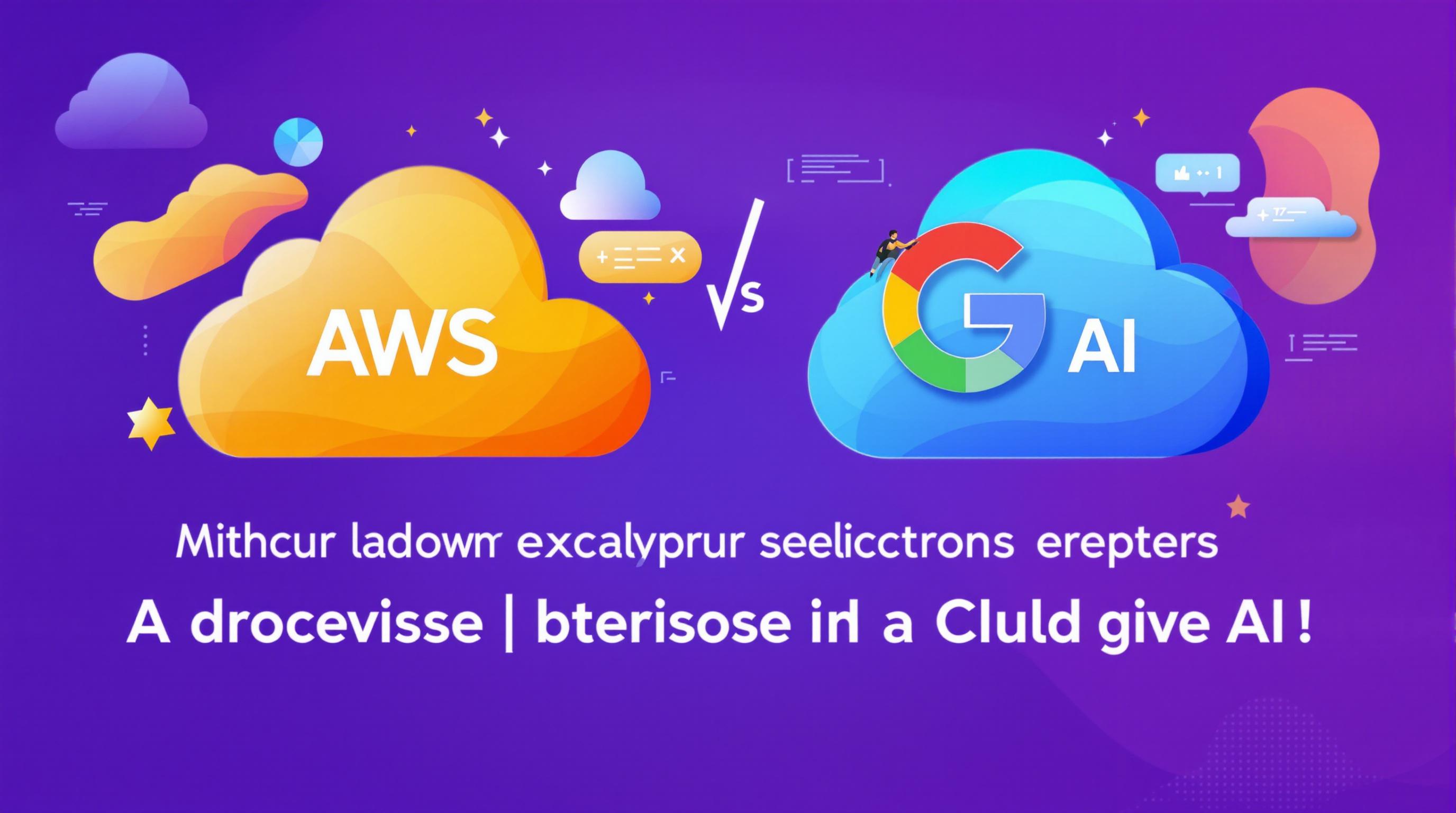
Back to Blogs
Scaling Your Next-Gen SaaS with AWS AI Solutions: A Step-by-Step Guide to Cloud-Driven Innovation
Technology
Scaling Your Next-Gen SaaS with AWS AI Solutions: A Step-by-Step Guide to Cloud-Driven Innovation
Scaling SaaS applications is tough - managing growing data, maintaining performance, and controlling costs can be overwhelming. AWS AI tools like SageMaker, Lambda, and Redshift Serverless simplify this process by automating scaling and optimizing performance.
Key Takeaways:
- Challenges: Data bottlenecks, performance lags, and AI project failures (50% fail at deployment stage).
- AWS Solutions:
- SageMaker: For AI model training and deployment.
- Lambda: Handles serverless workloads and spikes.
- Redshift Serverless: Scales data analytics with up to 10x price-performance benefits.
- Steps to Scale:
- Evaluate your SaaS infrastructure (e.g., latency, throughput).
- Choose AWS tools that match your workload and budget.
- Monitor and optimize with CloudWatch.
With 90% of apps projected to be cloud-native by 2025, scaling SaaS efficiently is more critical than ever. AWS AI services provide the tools to handle this growth effectively.
For a deeper dive into AWS tools and how they can transform your SaaS scaling strategy, read on.
Preparing to Scale SaaS with AWS AI

Evaluating Your SaaS Scaling Requirements
Before diving into AWS AI solutions, take a close look at your SaaS infrastructure and performance metrics. Pay attention to key indicators like latency, throughput, and resource usage (CPU, memory). These will help you pinpoint bottlenecks and shape your scaling strategy.
It's also essential to monitor resource usage, especially during peak traffic times, to maintain steady performance. Your data architecture - whether it's a siloed or shared pool model - will also play a big role in scalability. Make sure it fits your growth plans [1].
Selecting the Right AWS AI Tools
After identifying your scaling needs and bottlenecks, it’s time to choose the AWS AI tools that best meet your requirements. For example, Amazon SageMaker is a go-to for deploying machine learning models, while AWS Lambda is perfect for managing fluctuating workloads with serverless computing [3].
When deciding on tools, consider your application's workload patterns, data complexity, and budget. For instance:
- AWS Lambda is ideal for handling unpredictable traffic spikes with its serverless scaling.
- Amazon Redshift Serverless is great for working with complex datasets, optimizing resource usage while keeping costs in check [4].
"AI-powered scaling and optimization for Amazon Redshift Serverless automatically adapts to varying workloads, providing up to 10x price-performance benefits." - Ashish Agarwal and Tim Kraska, AWS re:Invent 2023 [5]
With features like automated performance tuning, Amazon Redshift Serverless can significantly improve how variable workloads are managed [2]. Pairing tools like SageMaker and Lambda creates a balance between scalability and efficiency [3].
Integrating AWS AI Services into SaaS
Using Amazon SageMaker for AI Features

Amazon SageMaker makes it easier to add AI capabilities to SaaS platforms by supporting a variety of data pipelines and frameworks for training and deploying models. It helps automate tasks like model tuning and resource management, tackling common challenges like performance slowdowns and scaling issues.
SageMaker's automated model tuning adjusts resources and hyperparameters to improve both accuracy and cost efficiency. Its compatibility with built-in algorithms and widely-used frameworks simplifies the process of training models, enabling you to expand AI features across your SaaS application more effectively.
"Amazon SageMaker provides a comprehensive platform for building, training, and deploying machine learning models, enhancing SaaS applications' functionality and performance through automated scaling and optimization features."
While SageMaker powers AI-driven capabilities, AWS Lambda complements it by efficiently managing serverless workloads, providing a balanced strategy for SaaS scalability.
Setting Up AWS Lambda for Serverless Workloads

For serverless success, focus on functions with unpredictable workloads or those that run periodically. Lambda’s serverless design handles fluctuating demand smoothly, reducing resource limitations during high-traffic periods.
To optimize performance and cost, configure memory (512MB–1024MB) and timeout settings (30–60 seconds). Here's a quick guide to Lambda setup:
| Configuration Aspect | Recommended Setting | Purpose |
|---|---|---|
| Memory Allocation | 512MB–1024MB | Balances resource use for moderate workloads |
| Timeout Setting | 30–60 seconds | Prevents long-running functions from overusing resources |
| Concurrent Executions | Start with 100 | Provides enough capacity for typical workloads without overspending |
Use CloudWatch to monitor metrics like execution time, error rates, and throttling events to refine performance. Set up triggers tailored to your SaaS needs, such as API Gateway for HTTP requests, S3 for file handling, or scheduled events for recurring tasks.
Scaling SaaS with AWS AI Tools
Approaches to Scaling SaaS Applications
Scaling SaaS applications typically involves two strategies: vertical scaling (increasing server capacity) and horizontal scaling (adding more servers). AWS AI tools, such as Amazon Redshift Serverless, simplify this process by automatically adjusting resources in real time. These tools help tackle common SaaS challenges like resource bottlenecks and performance lags.
Improving Performance with AWS AI Services
AWS CloudWatch plays a key role in monitoring and predictive scaling. It ensures that resource usage stays within defined limits, optimizing both costs and performance. Implementing these strategies effectively depends on choosing the right AWS AI tools to meet your scaling and optimization needs.
Comparison of AWS AI Services for Scaling
| Service Feature | Amazon SageMaker | AWS Lambda | Amazon Redshift Serverless |
|---|---|---|---|
| Primary Use Case | AI/ML model training and deployment | Serverless computing and function execution | Data warehousing and analytics |
| Scaling Features | Automated model tuning and resource management | Auto-scales based on function invocations | AI-driven scaling across all dimensions |
| Best For | SaaS apps needing AI features | Variable workloads and periodic tasks | Complex query processing and analytics |
| Performance Impact | Enhances AI feature performance | Cuts down operational overhead | Delivers up to 10x better price-performance |
"Amazon internal tests demonstrate that AI-driven scaling and optimization in Amazon Redshift Serverless can provide up to 10x better price-performance for variable workloads" [2].
For SaaS applications experiencing growth, tools like Amazon RDS Proxy can optimize database connections, boosting both scalability and performance [1].
Conclusion: Scaling SaaS with AWS AI
Key Points for SaaS Scaling Success
Scaling a SaaS business with AWS AI tools requires careful planning and smart execution of AI-powered solutions. Tools like Amazon SageMaker and AWS Lambda play a key role in improving performance while keeping costs under control. Companies using these tools have seen better scalability through automated resource handling and smarter workload distribution [3].
Selecting the right data partitioning model - whether silo or pool - is essential as the number of tenants increases [1]. Combining vertical scaling with tools like AWS RDS Proxy ensures stable performance even during periods of rapid growth [1].
With more SaaS companies adopting AI for scaling, advancements in cloud technology are reshaping how the industry operates.
Future Trends in SaaS and AI
Serverless architectures, especially those powered by AWS Lambda, are becoming more popular for their ability to optimize resources and manage costs effectively [4]. These trends support the strategies outlined above, helping SaaS providers create scalable and efficient applications.
| Trend | Impact | Implementation Strategy |
|---|---|---|
| AI-Enhanced Features | Better customer experience and automation | Use SageMaker for machine learning |
| Serverless Architecture | Cost-effective scalability | Deploy AWS Lambda for handling workloads |
| Cloud-Native Services | Improved performance and innovation | Utilize AWS AI for resource optimization |
The future of SaaS growth will lean heavily on AI-driven tools, like SageMaker, to dynamically adjust resources based on performance and demand. This evolution allows SaaS companies to scale effectively while keeping expenses in check [3].
Invoking a SageMaker model from a Lambda function
FAQs
Here’s a closer look at some common questions about how AWS AI services support SaaS scalability and their practical applications.
What is AWS AI service?
AWS AI services offer tools and frameworks designed for machine learning, automation, and data analytics. These tools help SaaS applications grow efficiently by powering features like personalization, modernizing contact centers, and improving security measures - all while supporting scalable growth [6].
| AWS AI Service | Primary Function | Key Benefit |
|---|---|---|
| Amazon SageMaker | ML Model Training & Deployment | Adds AI/ML capabilities like predictive analytics |
| AWS Lambda | Serverless Computing | Enables event-driven architecture and automatic scaling |
| AWS Auto Scaling | Resource Management | Optimizes performance [6] |
AWS Auto Scaling doesn’t add extra charges beyond the resources used and CloudWatch monitoring fees, making it a cost-efficient solution for scaling SaaS applications [6].
"Amazon internal tests demonstrate that AI-driven scaling and optimization in Amazon Redshift Serverless can provide up to 10x better price-performance for variable workloads" [2].
To get the most out of these services, use AI-driven scaling to adjust compute resources in real-time. This approach ensures both high performance and cost efficiency, which are crucial for growing SaaS platforms [7]. By carefully integrating these tools, SaaS providers can achieve scalable growth while keeping operations efficient.
Things to consider when selecting AWS AI services:
- How well they align with your SaaS scaling needs
- Compatibility with your current infrastructure
- Opportunities for resource optimization
- Cost-efficiency for long-term growth plans
Related Blogs

Technology
15 Jan 2025
Implementing AI Agents at Scale: Strategies for Sustainable Enterprise Adoption
Learn effective strategies for scaling AI agents in enterprises, addressing challenges like integration, security, and performance optimization.

